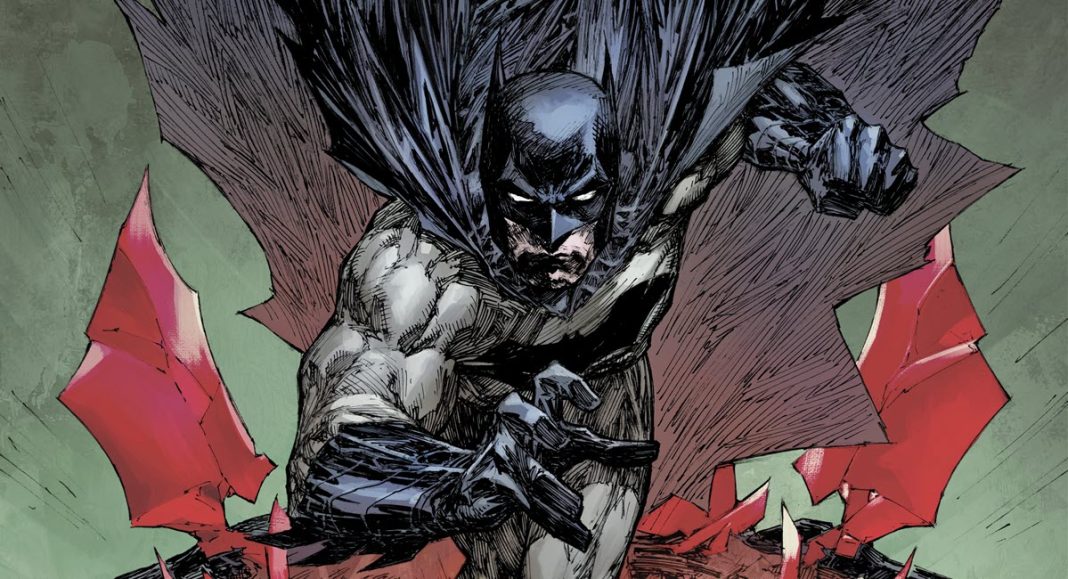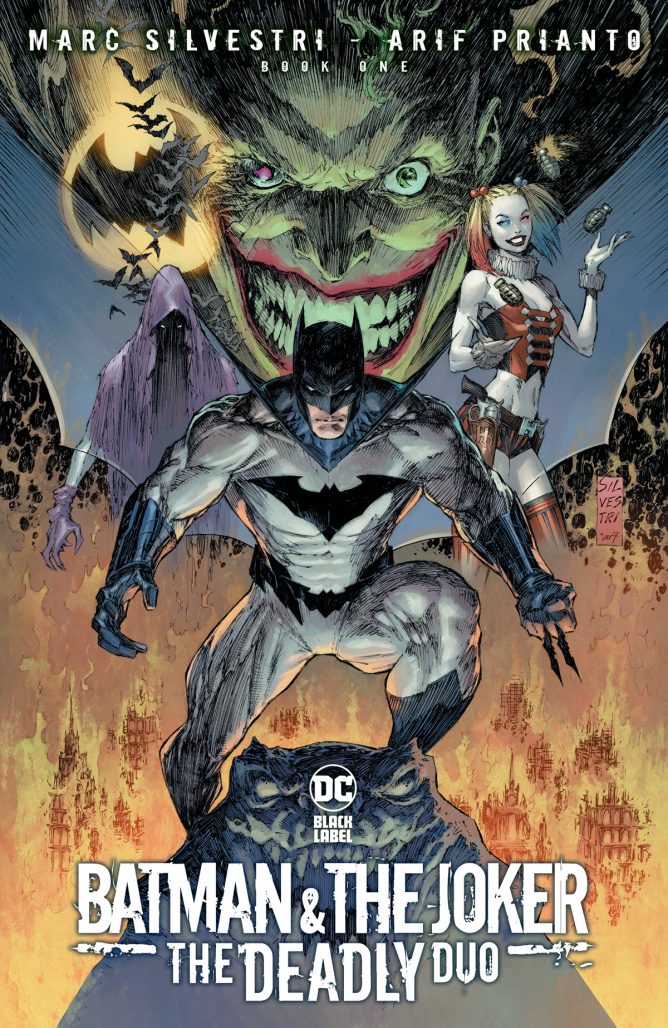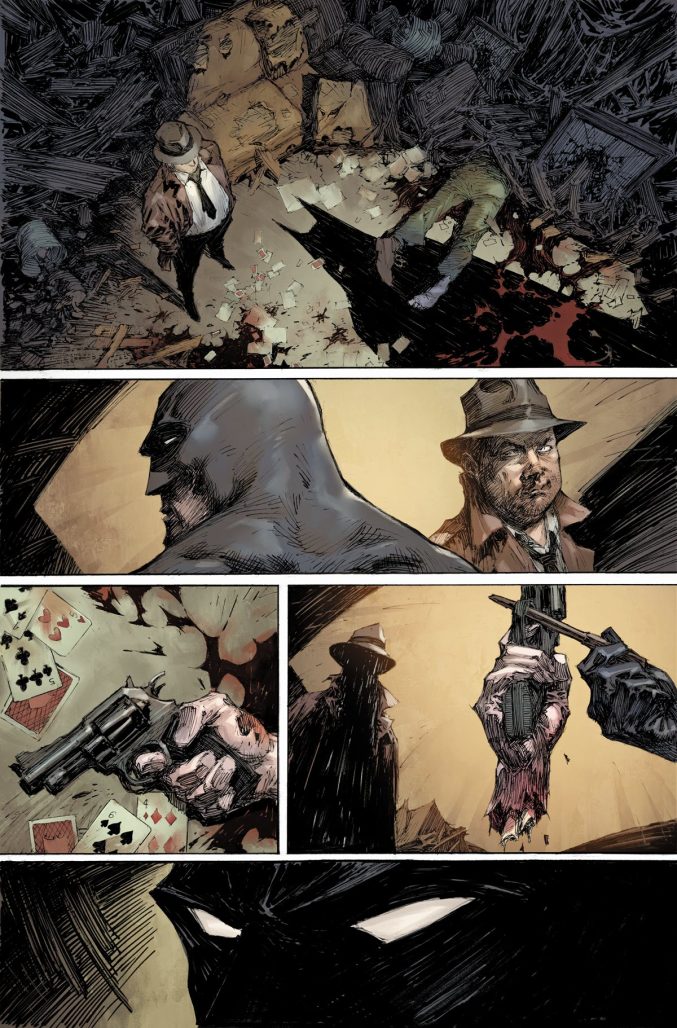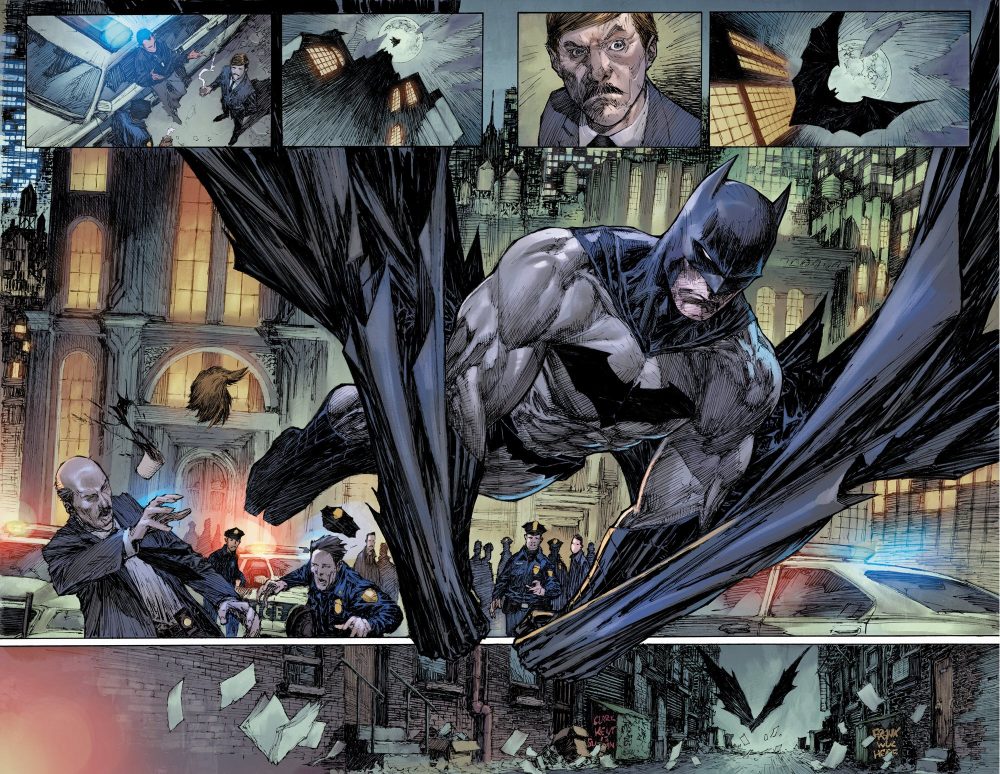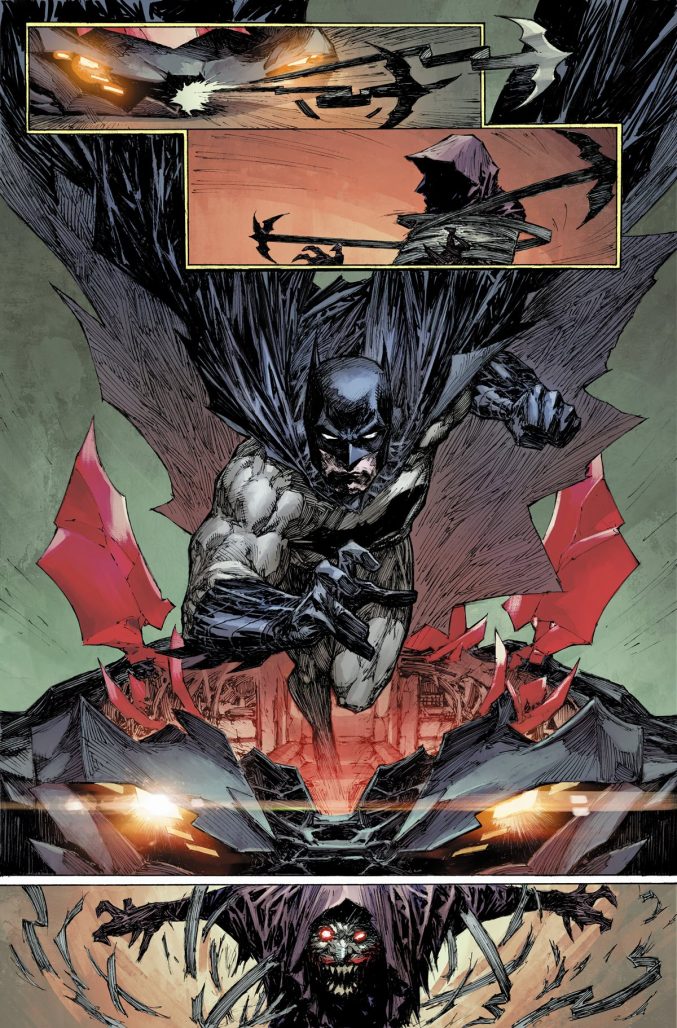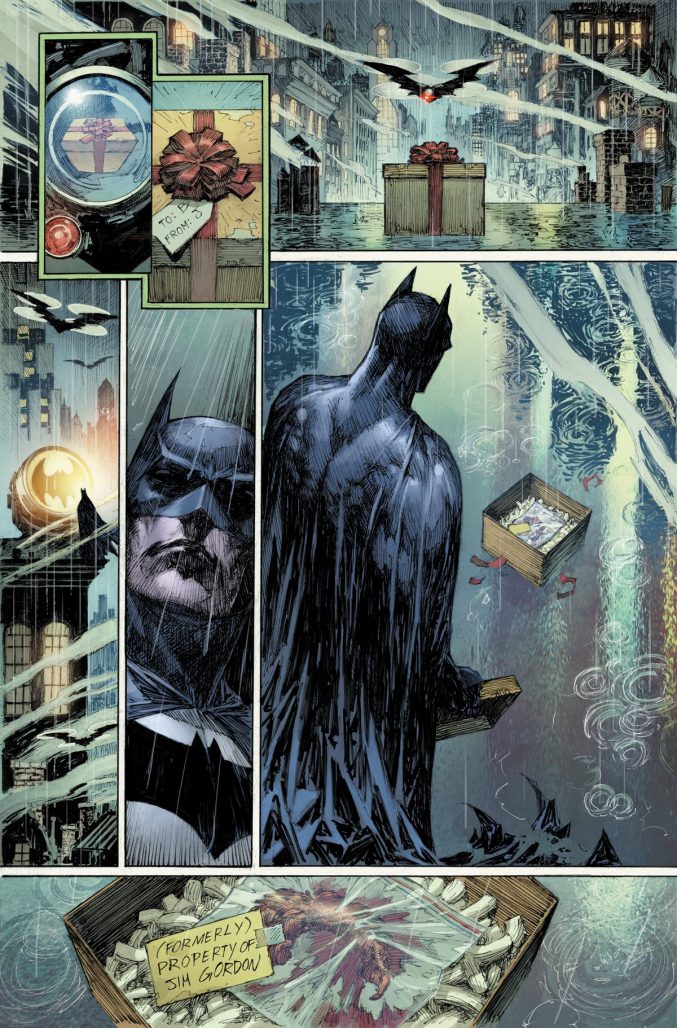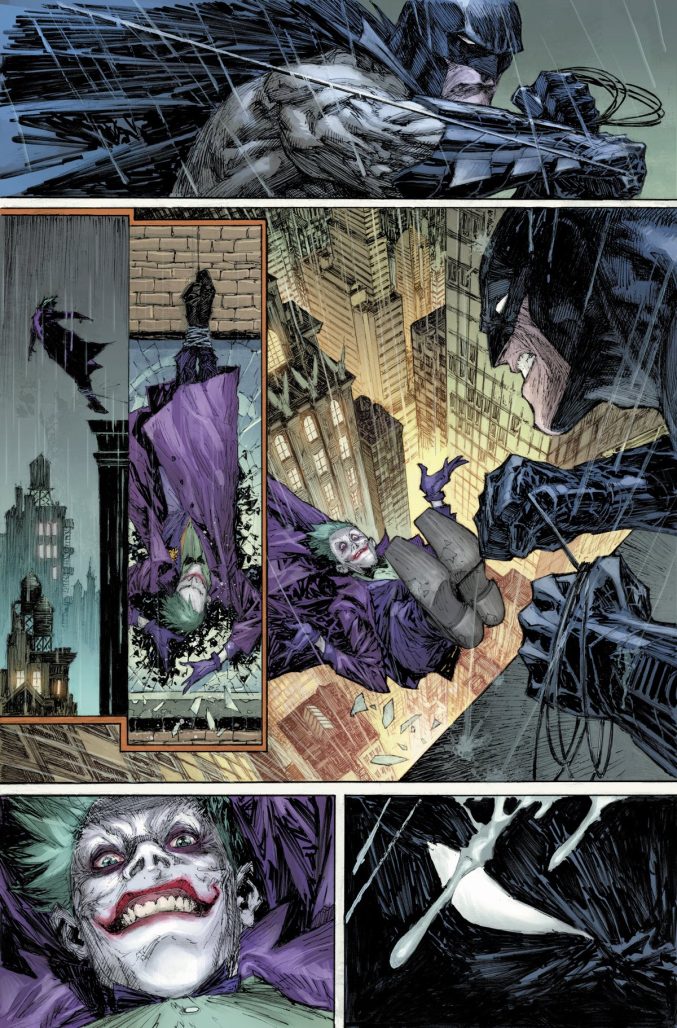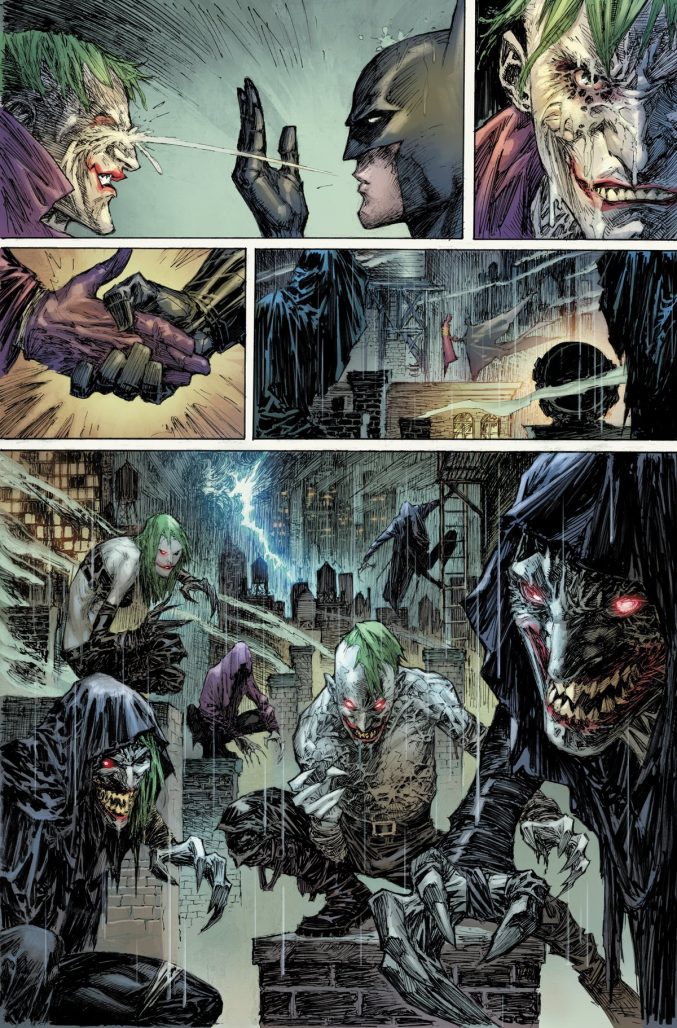Marc Silvestri‘s long-awaited DC Black Label series, Batman/The Joker: The Deadly Duo, finally arrives in stores this week. The series sees the dark knight and the clown prince of crime forced to join forces against a new threat to Gotham and to each of them personally. It’s the first major work for DC Comics from Silvestri, whose earliest comics credits include fill-in issues of Ghosts, House of Mystery, The Unexpected, and Weird War Tales in the early ’80s, but whose only interior work for the publisher since then is a Batman short story from the 1996 Batman: Black & White miniseries.
With the first issue of Batman/The Joker: The Deadly Duo now in stores, The Beat chatted with Silvestri about the origins of the new Black Label series, the benefits of setting the series outside of continuity, and the horrifying moment he can’t wait for readers to experience.
Joe Grunenwald: We know a little bit about The Deadly Duo. We’re seeing Batman and The Joker in a different situation than they’re typically in.
Marc Silvestri: Isn’t that weird?
Grunenwald: Yeah, it is weird. So what’s the dynamic between them? I mean, I’m sure they’re not best pals. But I bet it’s a lot of fun to work on.
Silvestri: Well, here’s the thing. I’ve known Jim [Lee] for 30 plus years, right? And ever since he went over to DC, he’s been bugging me, like, once a year, ‘Hey, c’mon, do a Batman thing.’ You know, I did a couple of Batman illustrations. That was in their [Batman: Black and White] books. [Jim was] always like, ‘You would do a great Batman, do a Batman.’ So I’m like, I have a job to do and a business to run out. I’ve got a life to lead, y’know? And finally, just about seven years ago, I just went, you know what? I’ll just pitch this idea, because I always thought this would be a fun thing to do. But I’m not Mr. Batman Historian. I don’t really keep up on things that much. So I figured, you know, Batman has been around for 80 years, this idea has been done a bazillion times. I’ll pitch it. They’ll say no, and I’m out. [laughs]
So I was sitting with Bob Harras at San Diego Comic Con, and I throw my idea out there. And my simple one sentence pitch was, ‘Batman and the Joker have to team up together to fight a brand new common enemy. So, thank you for your time.’ And Bob goes, ‘That’s awesome.’ I couldn’t believe it. This was before Batman turned 80. So you know, Batman is almost 80 years old, and you guys haven’t done this idea to death? And he said no. Okay. In my head, I’m going, it writes itself. Right. And the reaction that you had to it is exactly the reaction that I’ve been getting, and that I wanted, like, wow, that’s kind of cool and interesting. Because in my head it’s like, well, the story just really writes itself, because you’ve got literally, arguably, in my opinion, and I think a lot of people’s opinion, the two most iconic pop culture characters, outside of Mickey Mouse and Donald Duck.
Grunenwald: Disney’s Batman and Joker.
Silvestri: Yeah, right? There you go. They’ve always been compared at least in modern times to, and I think it’s accurate, two sides of the same coin. Right. And for me, it was always like, that’s absolutely true, because, well, which one’s actually crazier. And my idea for the story was very simple. It’s like, what if, over the span of a number of issues, they suddenly had to be on one side of the coin, and they had to work together. Because you have these two technically diametrically opposed forces that have been at each other’s throats for 80 years now. And they would be literally forced to work together because of some new threat to both of them. So I explore the idea of, what’s important to you, and how far would you go to protect that thing that’s important? And the fact that Joker basically gives Batman no out, at least to start with. It was very important, like, how do I get Batman to this moment where he has to team up with The Joker? So at least at the end of the first issue, he’s made that deal with the devil, right? But it’s like, what does that really even mean moving forward?
And there’s a moment later on – I will spoil this for you sort of kind of – but to me, it’s one of my favorite parts. And I have a few of them. One of my favorite parts in the whole story is when Batman – and the reader hopefully, to their horror – find out that not only does Batman have to work with the Joker, but he finds out that he needs the Joker. And there’s this moment of utter frustration. Rarely Batman can’t handle crap on his own, or he voluntarily enlists people. And he finds out at a point in the story that he literally can’t do this without the Joker. And it’s just a great moment, right? When I first started writing this I had my beginning and I had my ending, and then I had that moment, and then I had to fill in everything else to make it fun, because when you think about the concept that these two have to, literally have to work together, I mean, it’s ludicrous, and to my mind immediately just entertaining. It just writes itself in the form of drama and comedy, right? Because as dark as this goes, and it goes dark. In fact, Ben Mears, the editor on the book, has described it as Apocalypse Now. And I said, ‘Dude, that’s perfect,’ because that’s the vibe I was looking for. Because it really is a journey into the heart of darkness, specifically for Batman. Because the Joker is crazy, right?
Grunenwald: Yeah, yeah. So you said they’re on the same side of the coin now. Is Batman pulling the Joker into his particular kind of crazy? Or is the Joker pulling Batman? It sounds more like it’s the Joker pulling Batman into his particular form are crazy.
Silvestri: Remains to be seen, doesn’t it? But that’s part of the fun, right? And what I’ve purposely done here is that it’s an unfolding mystery. I hold the reveal of the ultimate villain for as long as I can. Because it’s about how these two forces of nature have to work together to solve this new horrifying thing that’s going on in Gotham, right? So to answer your question, I hope that I’m keeping the reader on their toes, like, ‘who’s really in charge here?’ And one of the fun dynamics of the whole story for me, the whole concept in general, was [their] skillsets. And so I had to figure out situations and scenarios where the skillsets mattered, right? It was very important to me that the characters drive the narrative all the way through the end, and I hope [the ending] is surprising and satisfying for people.
But when you think about it, what’s Batman’s skillset? Well, he’s Batman. He’s physically Batman, he’s the world’s greatest detective, and he’s got wealth beyond imagining to fund his Batman-ishness. And what does the Joker bring to the table? Well, his skillset is he’s crazy. And he’s a sociopath. That’s literally his skillset. And that moment, when Batman figures out that he actually needs this guy, is the horrifying moment when the reader realizes that Joker’s skillset, the chaos, his murderous nature, is actually an asset in the story to Batman, and he realizes that he needs this chaotic force to help him to find what he needs to find through this mystery. And so to me, that’s the fun stuff. That’s the real meat and potatoes. Here is how these two characters, they’re forced to be on the same side, and what does that mean for them as characters and as human beings? Although an argument can be made that no, they’re kind of barely human beings, really. Joker, for sure not, because he lacks everything that makes you human. And then Batman, well, borderline, right? It makes them [both] a little untrustworthy, and those are the things that I kind of like to explore.
It’s like, there’s this weird thing about Batman. Part of the thing that I love about him is that, even if you’re on the side of good, even if you’ve done nothing wrong, and I play with that a little bit in here, if you’re in a room with him, you’re not comfortable. It’s rare in a hero that you literally do not trust him, because he’s always thinking about his goal, and sometimes his goal may not include you and your safety right in that moment. That’s something that always intrigued me, and that makes me love him so much as a character. You’re always leery of this guy. And that’s just fascinating to me.
Grunenwald: Yeah, that’s a really interesting perspective on him. It’s not something I’d considered before.
Silvestri: Yeah. It’s like, he’s the hero, the defender of Gotham, but at the same time, when that Bat-signal shows up in the sky, it should be comforting, but sometimes it’s not. Because who is this mysterious guy who works outside the law, who apparently helps the innocent? Maybe kinda? Who knows? What’s this guy’s agenda? Nobody really knows. To a certain degree, neither does he. I have one character that’s smarter than everybody, or at least more insightful than everyone, and this isn’t a spoiler, but it’s Alfred. He’s in this because this is out of continuity, which is great. I can do what I want. And you know, you’ve read the first issue, so you know that things happen.
Grunenwald: You do what you want. So you mentioned it’s been seven years since you pitched this book. Have you been actively working on it for seven years? Or has it just sort of been in your mind for that long?
Silvestri: I started working on it around that time after I pitched it. And to Jim and DC’s credit, they’ve been really good about it. They’ve been very patient to let me get this thing done, because I do have this other life that I have to take care of. So there’d be times where, you know, suddenly, it’d be like midnight, like, ‘Oh, crap, I should do some Batman pages.’ [laughs] But you know, here’s the thing. I’ve been doing this for so long. Plus, let’s not forget that the world like literally went on fire, and I had to take care of that stuff with the business and all that. I was actually in the homestretch before everything kind of went to hell, and then it’s like, ‘Oh, shit, more stuff to do.’
But for me, I’ve been in this business since 1981, and one of the things that I wanted to make sure of was to take advantage of the fact that, in my business, we’re not athletes. There’s no shelf life physically for us, as long as we have our facilities that we can do our job. It’s not like we’re professional football players lucky to have a ten-year career, right? We can keep doing what we do until the brain doesn’t work anymore. So I kind of wanted to go, ‘You know what, I’ve done comics this way for most of my career, I want to try some new stuff.’ So I want to challenge myself, number one, writing for myself at this level, which I’ve never done before at this scale, and challenge myself artistically, because people know me as a certain way in my art, and I wanted to switch things up a little bit. I went through this old school kind of heavy line work, Franklin Booth look, which is where Bernie Wrightson got his inspiration for Frankenstein, and I kind of went like, ‘Wow, what if combined that with modern comics aesthetics and put those together, and what would that look like?’ So unfortunately, that became extremely time-consuming, and I realized like halfway through the first issue, ‘What the hell did I do?’ And I wanted to make sure, and one of the reasons why it took so long is…look, comic fans are awesome. They supported this business and they supported me and people like me for years and years and years, through thick and thin. The last thing I want to do as a creator is cheat the audience, right? And it’s like, they’re gonna put some hard earned cash in there, so hell if I’m just gonna shortchange them. I put everything I could in that moment in each page, and hopefully it it pays off, and hopefully the readers will respond to it both as a story and also visually.
But yeah, as I was writing it, I got caught up in the story, just all these ideas coming up, though completely forgetting about the artist, me, who has to draw this stuff. I had promised myself that I’m writing it, so I’ll just write what I want to draw, so it’s like when the story took over, the characters took over, and it was just like, ‘Well, I HAVE to do this.’ So when it came to drawing it later, I just go, ‘Damn that writer, I’m never going to work with that guy again. He’s killing me here.’ [laughs] But I made sure that, along with the amalgam of the the old school line work I wanted to do with modern comics, I also wanted to put in a good dose of that ’90s bombast. I mean, who doesn’t want to see two double-page spreads of Batman doing Batman stuff? You want to see that, right? And you can still tell the story and have those quiet moments. That is a good reason why the book is seven-and-a-half-ish pages long. The last issue is not quite double-sized, but it’s an extra 10 pages of story. So, you know, you want to have those moments when someone turns the page, they’re looking at it or that on their phone or their tablet. Turn that page, and there’s Batman doing Batman stuff. Also he’s doing Batman stuff with Joker. That’s crazy. And then you get to the quiet stuff and all that, but you know, we’re here to entertain.
Grunenwald: Yeah, you touched on it a little bit, you know, Batman doing Batman stuff. But do you feel like there are essential elements that you have tried to or have to include to make it a Batman story or a Joker story?
Silvestri: Yeah, I mean, look, you gotta be respectful to your audience. You can have some fun, you can push some boundaries, which Black Label allows me to do, but at the end of the day, you have to give them Batman. You have to give your audience Batman and Joker and whoever else – there’s a few cameos that show up – but you need to be true to that. So I was very conscious of that. I do my own version of Batman, because I was like, ‘Okay, what’s my Batman gonna look like?’ This was around the New 52 stuff, whenever that was, but it’s like, okay, well, who’s doing Batman now and what does it look like? I want to be respectful to DC and the audience and all that. And then I realized that, wait a minute, everybody does their own Batman, but you can always tell it’s Batman. So it kind of freed me up. And it’s like, okay, well, my Batman looks like this. I didn’t want an armored Batman because I personally don’t think that works in comics. It works great in cinema and television. I think it makes sense there. But I think in comics Batman is an intimidating force of nature, and I wanted him to be just this physical force not hidden by armor. I want him to be exposed. He doesn’t need to be behind armor in a comic book. He’s just he’s putting himself out there, this is me, fight me. So I wanted that attitude in there.
But it was important that, you know, what does Batman have? Well, Batman is also Bruce Wayne, so what’s Bruce Wayne’s deal in this story, and how does that matter, and which is the real person? I play with that a little bit, too. I mean, Batman has toys, he’s gotta have toys, right? He’s a billionaire now. And he’s got to have the Batcave, or if you saw in the first issue it’s the Batcavern.
Grunenwald: You’ve worked with Batman a few times now on covers and such. Are there any other characters or corners of the DCU that you’ve got an itch to explore?
Silvestri: You know, Batman was my favorite. I grew up watching the TV series, to age myself.
Grunenwald: This series is a far cry from Adam West. [laughs]
Silvestri: Tonally it’s a little different. [laughs] Yeah, I mean, no one loses their head in the TV series. But yeah, like I said, Batman is one of my favorite characters, and I’ve been wanting to tell a version of this story for a long, long time, it just always struck me as, wouldn’t that be just cool, I just never got around to it. And when I was given permission to make it a standalone that had nothing to do with continuity, that actually kind of changed the story in my mind. I still knew where I was going to start, and sort of where I wound up, but now I no longer had to wind up specifically here, because I was no longer tied to continuity, which was awesome. Bob Harras even said to me, ‘Look, don’t worry about it, make this evergreen. Make this something that someone could pick up 20 years from now as a collected graphic novel or whatever, and they could still just enjoy this as a Batman/Joker thing.’ So cool, that’s all I needed to hear as I went from there.
But, you know, I was asked this question before, like, who else would I want to play with in that universe? And it keeps coming back to Batman. Like I don’t know if I could do service to other characters. I think Batman specifically fits my aesthetic. I made it very gritty. Especially inking my own work, I was able to give it that kind of scratchy feel that had a lived-in textural feel to it. In fact, Gotham itself was interesting to me. The other show that I grew up on in the ’60s was the original Star Trek, and a lot of people will forget or don’t realize even that Star Trek had four main characters. You had Kirk and Spock, you had Bones, and you had the Enterprise. Those were your four leads, right? And I looked at Gotham the same way. So when I wrote this, I considered Gotham, and even the Batcave to a certain degree, to be a living, breathing organism, another character. So I wanted to kind of give it that organic look, to feel more like a living forest than a steel and glass structured environment. Right. It’s like, there’re scenes that require Gotham to be claustrophobic and closed in, and there’re other scenes that are required to be expansive. And for my design, right away I knew that my Gotham is gonna be a combination of, like, diesel punk meets The Wizard of Oz‘s Emerald City. Depending on where you are in the story, that’s where it leans, because I wanted the environment to feel, when necessary, protective and embracing of the characters, and other times to be scary and terrifying, depending on where you are. Hopefully I did that part of the job, too. And again, it’s all in service to a character-driven storyline. I’m a firm believer that your story moves forward simply because of the decisions your characters make, and I want to make sure that my Batman isn’t perfect. He makes early mistakes that he pays for basically through the entire series. And to me, that was that was important. And one of those things that was part of trying to fix it was going back to that horrifying realization that he needs the Joker, he needs his help. That’s just terrible. You’ve got these two characters and they’re working together, and one of them is having the time of his life, and the other one is living in hell. I’ll leave it to you to figure out which one is which. [laughs] But, hopefully, at the end of it, the reaction I want from the readers is they’ll put the book down and go, ‘Wow, I wasn’t expecting it to go there,’ but be satisfied by that. It’s like ‘Oh, man,’ and then they pick it up again and start to read it again, or go to their favorite spots. That’s what my goal is, and if I did my job right then hopefully that’s what happens.
Grunenwald: Is there anything else that you want readers to know? Can you tease anything about what the deal with the new villain is?
Silvestri: Aw, come on. [laughs] No, I don’t know about you but, not only do I dislike spoilers when they go across social media, but it’s like, It enrages me. You know, it’s so disrespectful. So like I said before, I’m gonna hold that reveal for as long as I can without annoying people, and as part of the detective work that this team has to get through, right? The only thing I will say is that things aren’t all that they seem to be, so I can tease that. There’s twists and turns, and hopefully some surprises in there that that will be like, ‘Oh, I didn’t see that one coming.’ But it’s fun, right? When you have a mystery that’s being solved by the world’s greatest detective, you want to make sure that mystery has stakes. And it’s not linear, right? It’s like, when your mystery is linear, it becomes too predictable. So I make sure to have all the twists and turns the lefts and the rights. I’ve described this as a buddy cop horror story, which is what it is. It does get dark, but at the same time, there’s humor in there, because to me, that’s the most fun horror stuff, when there’s something to break up the dark. And one of the great vehicles you have here with this dynamic is, Batman says maybe seven lines throughout the entire series to The Joker, right? But the Joker just won’t shut up. [laughs] So he gets all the fun lines, and Batman just has to keep doing his Batman stuff and stay focused.
Grunenwald: It sounds like, you know the Looney Tunes cartoons with the big dog and the little dog, and the big dog is just walking and the little dog’s hopping all around talking non-stop? It sounds sort of like that.
Silvestri: That’s a great analogy. I’m gonna steal that from you. But yeah, you have those opportunities all over the place, just by the concept alone. And, you know, I mined from it as much as possible, I could have made this 12 issues, if I want to kill myself, you know, but I think I give both characters an interesting arc, both individually and together. If I did my job right, it ends in a satisfactory manner, where it’s like, ‘Oh, that makes perfect sense.’ And the Joker’s insane, and he’s a sociopath. So if he doesn’t really learn anything, per se, about himself, so all the learning comes from the Batman side. Which is also fun, right? Because it’s frustrating for him. It’s like he’s a human being. He learns from his mistakes. The other guy doesn’t. [laughs] He’ll never change, which is one of the reasons why people love him as a villain.
Grunenwald: Yeah. With most buddy cop stories, I feel like by the end, the two characters have a sort of newfound respect for each other. I suspect Batman probably won’t have any respect for The Joker by the end of this. [laughs]
Silvestri: [laughs] Not gonna spoil anything for you. But I hope you enjoy the rest of the series. It was fun to do. It was a lot of work, but it was fun. And I hope that fun translates to the readers, and they are entertained by it.
Published by DC Comics, Batman/The Joker: The Deadly Duo #1 (of 7) is in stores now.


